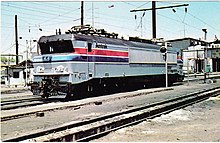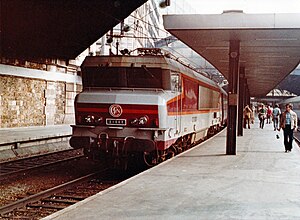railroad.wikisort.org - Train
The CC 21000 was a class of electric locomotives in service with the French railways SNCF, built by Alsthom in 1969 and 1974. It was a dual voltage version of the CC 6500 class working off both 1500 V DC and 25 kV 50 Hz AC. Initially allocated to Dijon, the first two, CC 21001 and CC21002, were fitted with cab signalling to allow them to operate test trains on the new high speed lines.[1]
Amtrak

In 1977, Amtrak borrowed SNCF CC21003 for testing purposes. This engine was rebuilt by Alstom with its transformer and electrical components replaced with those compatible with Amtrak's 25 Hz traction power system, taller pantographs, Amtrak's cab signaling system, US style couplers, a bell, and other components required by the AAR for operation on US railroads. This engine and a Swedish SJ Rc4 were imported and tested by Amtrak to determine the best design to replace the aging PRR GG1's operating on their Northeast Corridor. They were numbered by Amtrak as X996 and X995 respectively. However, the X996's suspension system proved unsuitable for the relatively rough US track construction, and despite modifications made over the course of testing, the engine's performance was deemed unsatisfactory for Amtrak's use. Thus, Amtrak favored the Rc4 design, which would serve as the basis for their EMD AEM-7. After testing was completed, X996 was returned to France, reverted to its pre-Amtrak appearance and specifications, and continued to operate on the SNCF.[2]
Disposal
The CC21000's were rebuilt into class CC 6500 in 1995 and 1996, taking the numbers BB 6575–BB 6578. All were withdrawn by 2006.[3]
References
- Garvin, Brian; Fox, Peter; Appleby, Chris (1986). SNCF/French National Railways. Sheffield: Platform Five. pp. 29–30. ISBN 0-906579-62-7.
- "Amtrak's X996". Amtrak Historical Society. Retrieved 6 September 2020.
- van Uden, Marco. "SNCF withdrawn locomotives". Railfan Europe. Retrieved 9 December 2020.
На других языках
[de] SNCF CC 21000
Die CC 21000 war eine Baureihe elektrischer Lokomotiven der französischen Staatsbahn SNCF. Die vier gebauten Maschinen waren für beide französische Stromsysteme (1500 V Gleichspannung sowie 25 kV 50 Hz Wechselstrom) konzipiert und waren zu ihrer Entstehungszeit mit 5520 kW die leistungsfähigsten Lokomotiven der SNCF. Ab 1995 wurden sie in die Gleichstromvariante CC 6500 umgebaut und dieser Baureihe zugeordnet (Betriebsnummern 6575 bis 6578). Im Jahr 2007 wurden die letzten CC 6500 ausrangiert, darunter die Lok 6575, die fahrfähig erhalten blieb (in Nîmes stationiert und wieder als Nummer 21001 bezeichnet).- [en] SNCF Class CC 21000
Другой контент может иметь иную лицензию. Перед использованием материалов сайта WikiSort.org внимательно изучите правила лицензирования конкретных элементов наполнения сайта.
WikiSort.org - проект по пересортировке и дополнению контента Википедии
